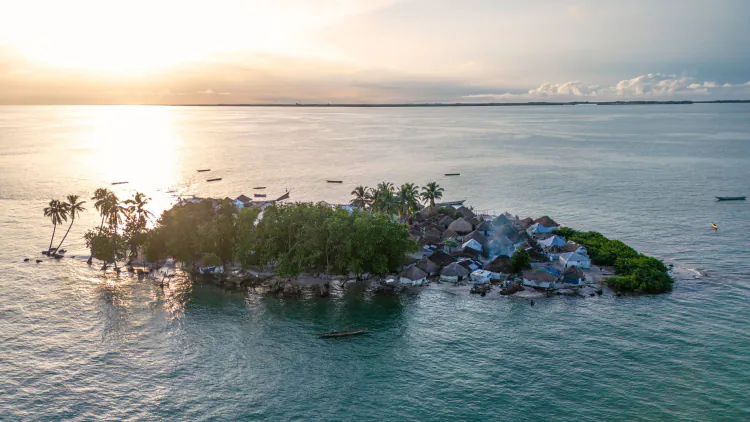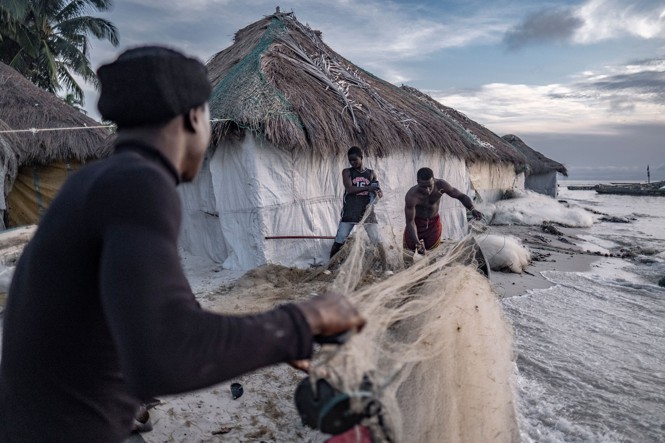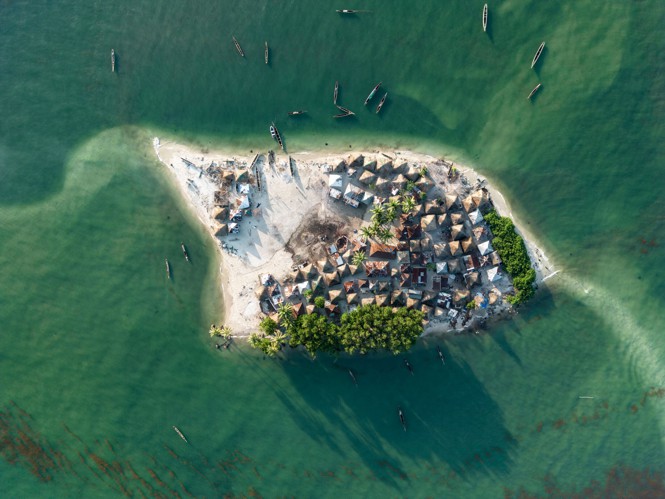I Watched This Island Wash Away in a Decade
Nyangai, in Sierra Leone, was once a bustling community. Now only 100 homes are still standing.

This article was originally published by Hakai Magazine.
Before the sea started taking house-size bites out of Nyangai, this small tropical island off the coast of Sierra Leone hummed with activity. I first visited in 2013 while documenting the construction of a school on a neighboring island. It was a cloudless day in April. A group of teenagers was busy setting up a sound system for a party. Old men chatted and smoked in the shade of palm trees. Children chased one another through the maze of sandy lanes while a constant traffic of roughly hewn wooden boats plied the surrounding waters.
The silhouettes of coconut palms and June plum trees dominated the island’s profile, and beneath them stood clusters of neat mud-and-thatch homes. The beach that ringed the island was so white, it hurt the eyes, the water a limpid green. I couldn’t stay for long, but Nyangai left a deep impression.
In December of the following year, I caught another glimpse of the island, this time while flying over it in a United Nations helicopter delivering emergency supplies to a nearby island at the height of the West African Ebola outbreak. From the air, it looked fragile, its curved, slender form barely 160 feet wide in places. I didn’t know it then, but the island I was looking at was a mere stub of what it had once been.
Nyangai (also spelled Nyankai and Yankai on some maps) is shrinking at an alarming rate, its sandy soil eroded by an ever-more-destructive sea. In the span of a human lifetime, the majority of its land has disappeared, and most of its population has fled. Those who remain, many of whose families have called Nyangai home for generations, are squeezed into an ever-decreasing patch of sand. Within a few years, many fear, the island may disappear altogether.
[Read: The village that will be swept away]
Returning to Nyangai in 2023, a decade after my first visit, I found the place almost unrecognizable. From a satellite image, I had seen that the island had been split in half by the sea, leaving two bean-shaped patches of land separated by a wide gulf. But as my boat approached, I could see only one: In the time since Google had last updated its satellite image in 2018, an entire village of several hundred people had vanished.
“The water is eating the island,” says Tewoh Koroma, a mother of six who lost her home to flooding in September 2023. “We already fled from the water once, and now we’re getting flooded again. The water is following us.”
Over the past decade, each new storm or flood has prompted more to leave. Some head for the country’s coastal capital, Freetown, or to other towns on the mainland, while others move to nearby islands. Nyangai’s leaders say there were once more than 500 homes here. Today there are fewer than 100.
The Turtle Islands archipelago, in which Nyangai lies, has always been vulnerable to erosion. The islands rise little more than 10 feet above sea level on average, and their loose soils are easily shifted by the ocean’s powerful currents. Stretches of shoreline slowly recede or advance, and offshore sandbanks come and go. But the crisis now unfolding on Nyangai is on a different scale. Over the past decade, the island has shrunk from roughly 2,300 feet long to just 560. Many blame the more erratic weather and more powerful storms. As one resident puts it, “Everything’s out of place.”
Life on Nyangai has never been easy. The island lacks roads, piped water, and electricity. Living conditions are basic. But only with deep reluctance do many finally leave. The island is peaceful, its community tight-knit. It’s free of snakes and has virtually no malaria. The fishing, on which nearly everyone relies, is better than elsewhere. During times of upheaval, from Sierra Leone’s civil war in the 1990s to the Ebola outbreak of 2014, the island has offered a level of sanctuary. For most, it is the only home they have ever known.
Nyangai is not alone in its existential battle with the ocean; similar scenes are unfolding along much of Sierra Leone’s coastline. In the village of Lakka, near Freetown, the ocean is washing away two-story concrete houses piece by piece. On Plantain Island, some 20 miles to the north of Nyangai, farmers have seen their agricultural land either contaminated with salt water or swept away altogether. And in the north of the country, residents of the bustling trading town on Yelibuya Island have found themselves forced to retreat ever farther inland to escape the encroaching sea.
“It’s becoming very alarming,” says Tamba Emmanuel Nyaka, the deputy director of the Climate Change Secretariat in Sierra Leone’s Environment Protection Agency, who recently visited some of the most impacted areas. “We realize that the problem is getting worse. People showed us where they used to live, where their cemetery was, their fields, houses, and now it’s just seawater. They’re constantly having to move.”
Government officials say natural processes are being exacerbated by a series of factors including changing weather patterns; rising sea levels; the felling of mangrove forests; and in more urban areas, the mining of beach sand for construction. In 2021, the government released a new National Adaptation Plan to address the impacts of climate change, but it’s hamstrung by a lack of data—the country’s marine meteorological station has been operating for only a few years—and a lack of resources. The government has implemented mangrove-restoration projects in some areas, but with limited success. As for Nyangai, an official confirmed that there are no plans to build any sea defenses.
Almost everyone still on Nyangai has lost at least one home in recent years, and some, like 35-year-old Gaya Bang, have lost as many as four. “We’ve spent so much money building new houses,” she says.
With so much uncertainty over the island’s future, most people now rebuild with basic materials: squares of sackcloth over a grid of sticks for walls; old metal sheets, commonly riddled with holes, for roofs. Gone are the neat mud-walled cottages I had seen on my first visit. Gone, too, is the island’s freshwater supply; the well water is now so brackish, it can be used only for washing. In the rainy season, islanders collect rainwater in buckets. In the dry season, they must travel an hour and a half round trip by boat to collect water from neighboring islands.
The atmosphere has also changed. Children still entertain themselves, devising games in the tree graveyards that ring parts of the island, but the electric energy of a busy fishing village has given way to a sense of lethargy. The island’s chief laments that the parties and cultural dances that used to be common have faded away. These days, he says, the sound system comes out just once or twice a year to mark the rare visits by campaigning politicians.
“We’ve been telling the government … that we need help,” says Hasan Kargbo, the island’s harbor master. “But so far we’ve seen nothing.”
Facing little prospect of outside intervention, the islanders attempted to stem the erosion by planting mangroves, but few of the seedlings survived for long. When the island floods during the highest tides, some build levees of sand around their homes, bolstered with sheets of tarpaulin, lengths of timber, car tires, or any other sturdy objects they find lying around. Beyond that, they can’t do much but wait for the tide to go down.
“We love our island,” says Kargbo, who has already started looking for a piece of land on the mainland to start a new life with his wife and six children. But “it’s going to disappear.”
What's Your Reaction?




















